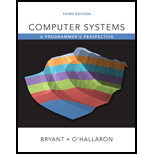
A.
Fractional binary numbers:
If each binary digit or bit bi ranges between “0” and “1”, then the notation represented by the below equation
Round-to-even rule:
- This rule rounding can be used even when user are not rounding to a entire number. The rounding can be calculated by using whether the least significant digit is even or odd.
- To binary fractional number, the round-to-even can be used by considering least significant value “0” to be even and “1” to be odd.
Example:
The example for round-to-even is shown below:
Consider a binary number is “10.000112” that is fractional
- From the above binary number, the decimal for “10” is “2”.
- Here the rounding the values nearest to 2 bits to the right of the binary point.
- Hence, the result after rounding is “10.002”.
B.
Fractional binary numbers:
If each binary digit or bit bi ranges between “0” and “1”, then the notation represented by the below equation
Round-to-even rule:
- This rule rounding can be used even when user are not rounding to a entire number. The rounding can be calculated by using whether the least significant digit is even or odd.
- To binary fractional number, the round-to-even can be used by considering least significant value “0” to be even and “1” to be odd.
Example:
The example for round-to-even is shown below:
Consider a binary number is “10.000112” that is
- From the above binary number, the decimal for “10” is “2”.
- Here the rounding the values nearest to 2 bits to the right of the binary point.
- Hence, the result after rounding is “10.002”.
C.
Fractional binary numbers:
If each binary digit or bit
Round-to-even rule:
- This rule rounding can be used even when user are not rounding to a entire number. The rounding can be calculated by using whether the least significant digit is even or odd.
- To binary fractional number, the round-to-even can be used by considering least significant value “0” to be even and “1” to be odd.
Example:
The example for round-to-even is shown below:
Consider a binary number is “10.000112” that is
- From the above binary number, the decimal for “10” is “2”.
- Here the rounding the values nearest to 2 bits to the right of the binary point.
- Hence, the result after rounding is “10.002”.
D.
Fractional binary numbers:
If each binary digit or bit bi ranges between “0” and “1”, then the notation represented by the below equation
Round-to-even rule:
- This rule rounding can be used even when user are not rounding to a entire number. The rounding can be calculated by using whether the least significant digit is even or odd.
- To binary fractional number, the round-to-even can be used by considering least significant value “0” to be even and “1” to be odd.
Example:
The example for round-to-even is shown below:
Consider a binary number is “10.000112” that is
- From the above binary number, the decimal for “10” is “2”.
- Here the rounding the values nearest to 2 bits to the right of the binary point.
- Hence, the result after rounding is “10.002”.
Want to see the full answer?
Check out a sample textbook solution
Chapter 2 Solutions
Computer Systems: A Programmer's Perspective Plus Mastering Engineering With Pearson Etext -- Access Card Package (3rd Edition)
- Capsim Team PowerPoint Presentations - Slide Title: Key LearningsWhat were the key learnings that you discovered as a team through your Capsim simulation?arrow_forwardWrite the SQL code that permits to implement the tables: Student and Transcript. NB: Add the constraints on the attributes – keys and other.arrow_forwardDraw an ERD that will involve the entity types: Professor, Student, Department and Course. Be sure to add relationship types, key attributes, attributes and multiplicity on the ERD.arrow_forward
- Draw an ERD that represents a book in a library system. Be sure to add relationship types, key attributes, attributes and multiplicity on the ERD.arrow_forward2:21 m Ο 21% AlmaNet WE ARE HIRING Experienced Freshers Salesforce Platform Developer APPLY NOW SEND YOUR CV: Email: hr.almanet@gmail.com Contact: +91 6264643660 Visit: www.almanet.in Locations: India, USA, UK, Vietnam (Remote & Hybrid Options Available)arrow_forwardProvide a detailed explanation of the architecture on the diagramarrow_forward
- hello please explain the architecture in the diagram below. thanks youarrow_forwardComplete the JavaScript function addPixels () to calculate the sum of pixelAmount and the given element's cssProperty value, and return the new "px" value. Ex: If helloElem's width is 150px, then calling addPixels (hello Elem, "width", 50) should return 150px + 50px = "200px". SHOW EXPECTED HTML JavaScript 1 function addPixels (element, cssProperty, pixelAmount) { 2 3 /* Your solution goes here *1 4 } 5 6 const helloElem = document.querySelector("# helloMessage"); 7 const newVal = addPixels (helloElem, "width", 50); 8 helloElem.style.setProperty("width", newVal); [arrow_forwardSolve in MATLABarrow_forward
 C++ for Engineers and ScientistsComputer ScienceISBN:9781133187844Author:Bronson, Gary J.Publisher:Course Technology Ptr
C++ for Engineers and ScientistsComputer ScienceISBN:9781133187844Author:Bronson, Gary J.Publisher:Course Technology Ptr Operations Research : Applications and AlgorithmsComputer ScienceISBN:9780534380588Author:Wayne L. WinstonPublisher:Brooks ColeNp Ms Office 365/Excel 2016 I NtermedComputer ScienceISBN:9781337508841Author:CareyPublisher:Cengage
Operations Research : Applications and AlgorithmsComputer ScienceISBN:9780534380588Author:Wayne L. WinstonPublisher:Brooks ColeNp Ms Office 365/Excel 2016 I NtermedComputer ScienceISBN:9781337508841Author:CareyPublisher:Cengage New Perspectives on HTML5, CSS3, and JavaScriptComputer ScienceISBN:9781305503922Author:Patrick M. CareyPublisher:Cengage LearningCOMPREHENSIVE MICROSOFT OFFICE 365 EXCEComputer ScienceISBN:9780357392676Author:FREUND, StevenPublisher:CENGAGE L
New Perspectives on HTML5, CSS3, and JavaScriptComputer ScienceISBN:9781305503922Author:Patrick M. CareyPublisher:Cengage LearningCOMPREHENSIVE MICROSOFT OFFICE 365 EXCEComputer ScienceISBN:9780357392676Author:FREUND, StevenPublisher:CENGAGE L C++ Programming: From Problem Analysis to Program...Computer ScienceISBN:9781337102087Author:D. S. MalikPublisher:Cengage Learning
C++ Programming: From Problem Analysis to Program...Computer ScienceISBN:9781337102087Author:D. S. MalikPublisher:Cengage Learning





